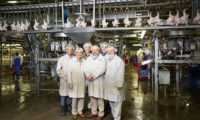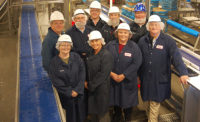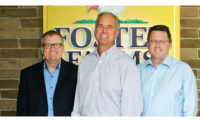Since 2005, Laurel, Miss.-based chicken processor Sanderson Farms has been on an expansion tear, building and opening five processing plants (with a sixth brand new plant planned to open in 2019), as well as hatcheries and feed mills to supply those facilities. It’s an unmatched record of expansion in the industry.
In January 2017, Sanderson Farms opened its St. Pauls, N.C., processing plant, the most recent addition to its roster, and Andy Hanacek, editor-in-chief of The National Provisioner, was invited to tour the facility in March. At that time he sat down with Bob “Pic” Billingsley, director of Development and Engineering, to get the details on the new plant and how it fits into the playbook of expansion and successful growth the company has followed during this decade-long run. What follows is a portion of their conversation:
Hanacek: Let’s start out by talking about this facility, here in St. Pauls. What led to Sanderson Farms building its newest plant here, rather than elsewhere?
Billingsley: We started the Kinston [N.C.] plant up in 2011, to serve the tray-pack part of our business, as we needed more presence up through the Northeast. We’ve got a very loyal customer base up there, and we needed to get closer to them. So when it came time to grow our company on the big bird side, we made the decision the same way, as a marketing decision. And so St. Pauls was a perfect fit, because it gave us an opportunity to do a better job of servicing our customers located in the Northeast. So, we knew from Day One, when we started site selection, that this facility would be a big bird plant designed to be able to service the foodservice industry, and it’s turned out just like we envisioned and expected.
We have 1,500 acres, and because of our need and desire to build land application [wastewater] systems, we are on much more land than we’d have needed just for a plant. Further, the soil conditions were good up here to be successful with the land application system.
Hanacek: Were there any unanticipated roadblocks in construction or startup that Sanderson Farms had to overcome?
Billingsley: You always go into a project understanding there’ll be issues you’d have to deal with. The issue here was the influence the weather had on the project. Of course, we had no control over the weather — all we can do is manage our responsibilities. But 24 months ago, we set a schedule to start up in January of 2017, and we hit that date.
Hanacek: What advancements and innovations stand out about the St. Pauls facility versus some of your previous expansions?
Billingsley: As you saw going through first processing, we’ve made it more automated, less dependent on labor and more efficient. In de-boning, we’ve got more automation, which is ergonomically good for our workforce. We’ve got vacuum systems to handle products going to offal, as well as different screening processes there. We also have no odors, no issues environmentally — all those things we’re supposed to do every day as a public company and a good neighbor. From a food safety standpoint, because this plant was a green-field facility, we were able to incorporate our interventions on the frontend and not force an intervention into an area.
Hanacek: The company has wasted little time in getting the plant started up — when will the facility be running full speed?
Billingsley: We started the second week of January, and we have a very aggressive ramp-up schedule here. We’re planning on being up to full capacity within 12 months. All of our new plants run 250,000 birds a day, 1,250,000 a week. So that is our model of excellence that we can see for this plant as well. You’ve seen Kinston, and now you’ve seen this one, and in them, you see a familiarity in the architecture that we use in our plants. It’s not cookie-cutter, but we try to create consistency between plants, so that a manager who is familiar with one location will be able to acclimate and assimilate into another plant more quickly. It helps us cross-train people. So if there’s a problem in the engine room or there’s a problem at offal load-out, the manager doesn’t have to stop and think, where is that? Being consistent helps people be successful.
Hanacek: Sanderson Farms has developed a good reputation as a leader in wastewater handling in the industry, and the St. Pauls facility builds on that with its treatment plant and spray fields. How has Sanderson Farms been able to use its experience in wastewater treatment to lower its environmental impact with these new plants?
Billingsley: When you look at our environmental record of our company and our history, it doesn’t take long to understand that [being a good environmental steward] is something that’s really important to this company. We have a wastewater system design that we’re comfortable with, and each time we build a new plant, we try to incorporate more up-to-date technology into the design.
The fun part of the site selection and new plant process for me is when our neighbors and those people who have watched us build our plants see that environmental is important, and that we do what we said we would do when the plants start up. We have a responsibility to be good neighbors wherever we operate. That’s paramount to us being successful. Your balance sheet can be good, your profits can be good, your earnings per share can be good, but if you’re not a good neighbor, none of that will matter.
Hanacek: You mentioned as we were touring the facility that Sanderson Farms plans to capture the biogas off the lagoon on site as well. What is the timing on finishing that portion of the project?
Billingsley: The anaerobic process takes about three years to fully mature in our wastewater treatment facility, so that system will be installed in another two to three years. As soon as it is generating enough biogas to justify the expenditure, we’ll put it in. It takes time. We’re putting a system in now, in our Palestine, Texas, plant, which opened in [February] 2015.
Hanacek: Let’s shift gears to the bigger picture at Sanderson Farms. This plant is your fifth new plant since 2005, correct?
Billingsley: Well, with the announcement [in March] of a potential next plant site in Tyler, Texas, that will be six we’ve built since 2005, which means we’re averaging a new plant a little more than every two years — all green-field sites, all similar to what you’ve seen here — one in Georgia, two in North Carolina and three in Texas.
Hanacek: That’s quite an accomplishment, especially compared to new construction in the industry overall during that period. I’m not sure many processors could claim a similar record. So what, frankly, is Sanderson Farms doing that’s different to make all this green-field expansion possible?
Billingsley: As a public company, we have an obligation to every shareholder to make a return for that individual. We run a conservative company from a balance sheet standpoint. We’ve got a very healthy balance sheet, and because of that, we’re required to grow. It’s who we are and the way we operate, and it’s been good for us. There are other ways to grow a company, but this is the way that we found to be successful. We can maintain the best assets in the industry by doing what we do.
Hanacek: How does this growth mentality trickle down to all the employees throughout the company? To be adding a new facility full of new people every few years could be a shock to many systems in an average company.
Billingsley: Our company culture of growth is non-negotiable. When you sign on to come here, you sign on to that culture. One of the reasons it’s easier to transition our culture to our new employees when we build a green-field facility is we’re not buying an asset that is entrenched in a different culture, where different things are important to those people. We’re able to say, ‘Look, this is new and nice, this is the way we do things, and now here’s your opportunity.’ The standards in our company are not average, and an average company could not do what we do.
So the standards are higher. A lot of people accept that and get on and do well, but it’s a process that never stops. When I came to work here 32 years ago, we had 1,500 employees, and today, we’re approaching 14,000 employees. You never stop training or mentoring people. If you’re going to be successful, you have to make that part of your everyday process of running a business. NP










Report Abusive Comment